Monthly Active Users (MAU) stands as a fundamental analytics metric and often serves as a key performance indicator (KPI) when working on a mobile app or game.
MAU represents the number of unique users who have launched your app at least once within a given month and have been active in it. It's important to note that every user is counted only once in a 30-day period, regardless of the number of days they were active.
MAU helps you gauge the level of active user engagement with your product during a given month. By providing insights into the number of active users, the metric equips you with the information needed to make well-informed business decisions. Additionally, it serves as a foundation metric for calculating and assessing the values of other KPIs.
Let's dive into more detail regarding ways to calculate the metric using an analytics platform, the factors that influence it, and some methods of applying it to your project.
Calculating MAU in the Devtodev Platform
Devtodev analytics platform allows you to calculate a wide range of metrics and make data-driven decisions for your mobile app or game. This time, however, we are going to discuss MAU only.
If you haven’t integrated your project yet, you can practice calculating MAU using Devtodev’s free demo (no credit card required).
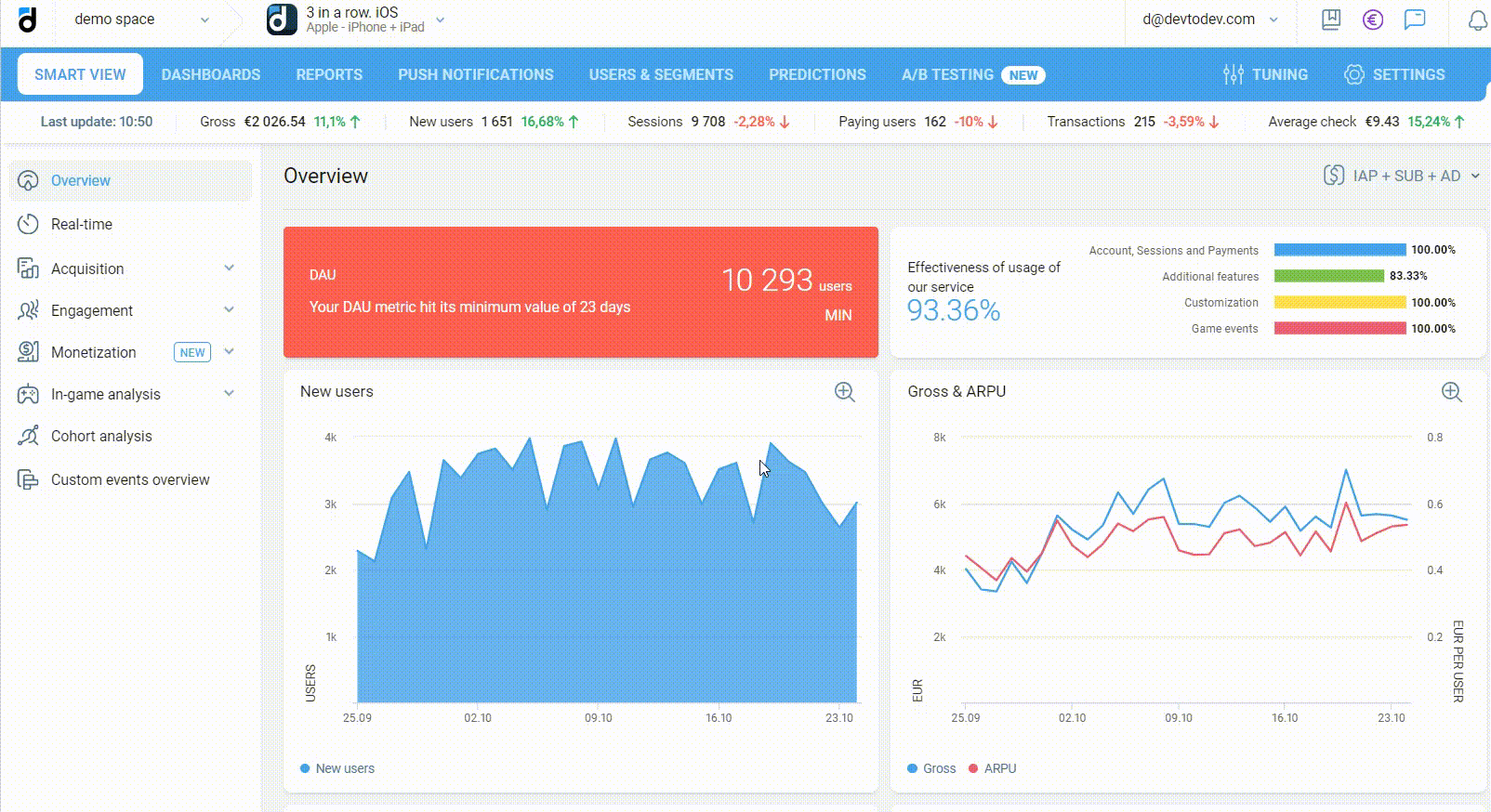
Inside the demo version, click “Reports” and select “Basic metrics”. Next, add the metric by clicking on the '+Metrics' option, then scroll down to find 'MAU' or type it into the search box. Select the date range you want to analyze and click “View result.”
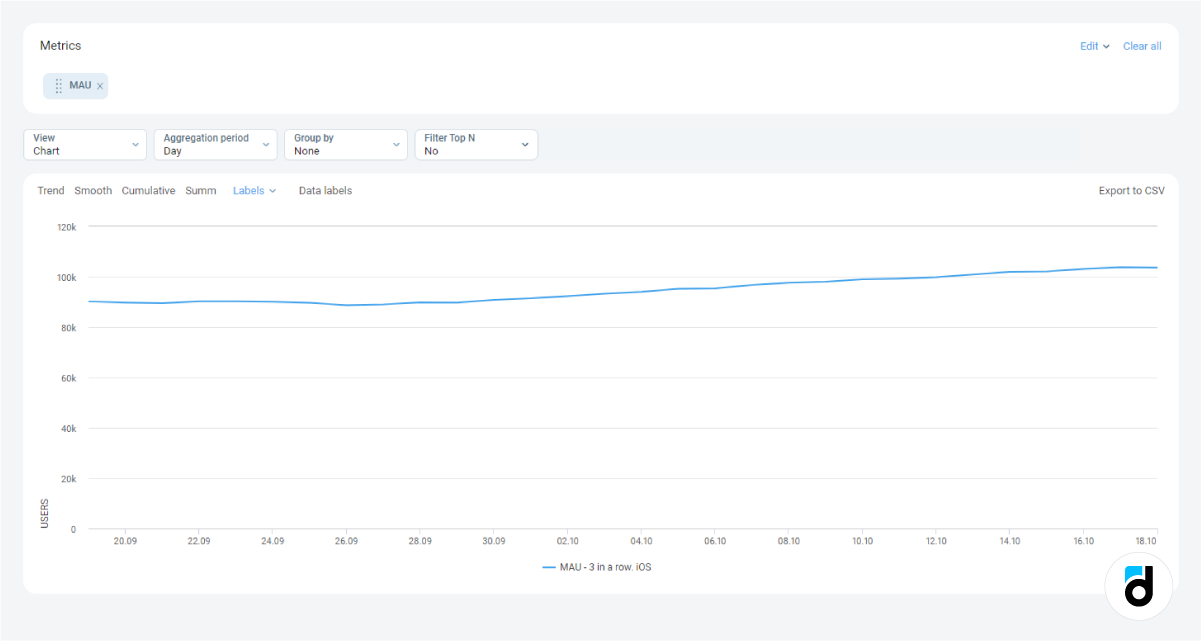
If you prefer to use other visualization methods, you can change data representation in the “View” tab. For example, if you want to add the number of monthly active users on your dashboard, select the “Number” view:
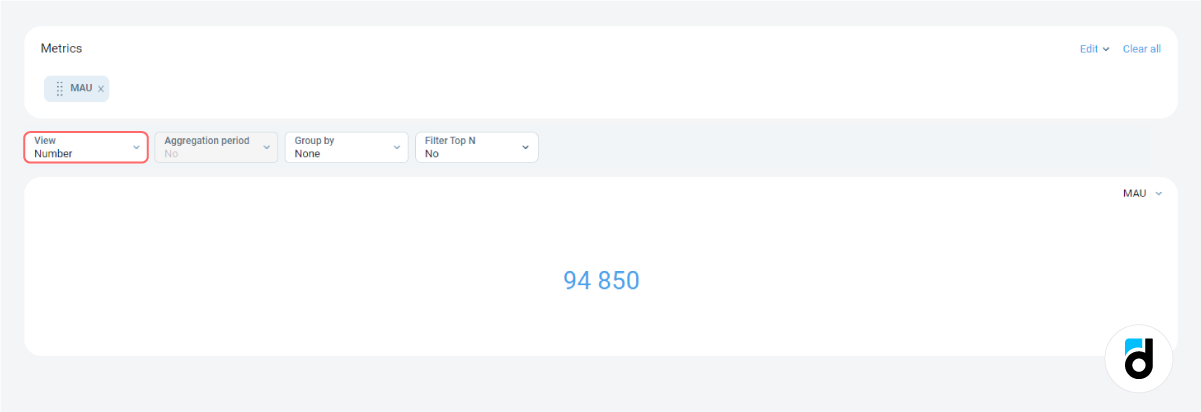
Next, hover over the three vertical dots menu in the top right corner and click “Save to dashboard.”
Devtodev offers various options of processing data on MAU. For example, you can group it by device and see which one performs better or present the data by countries:
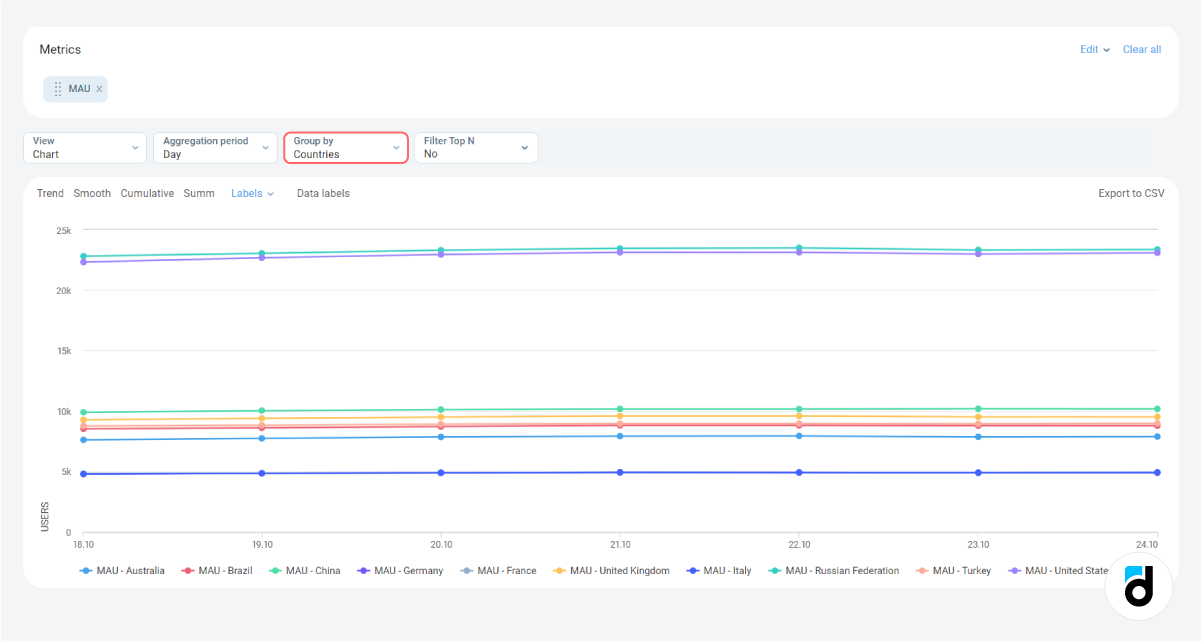
Or you can see data on acquisition channels, restrict the number to top three and present it as a pie chart:
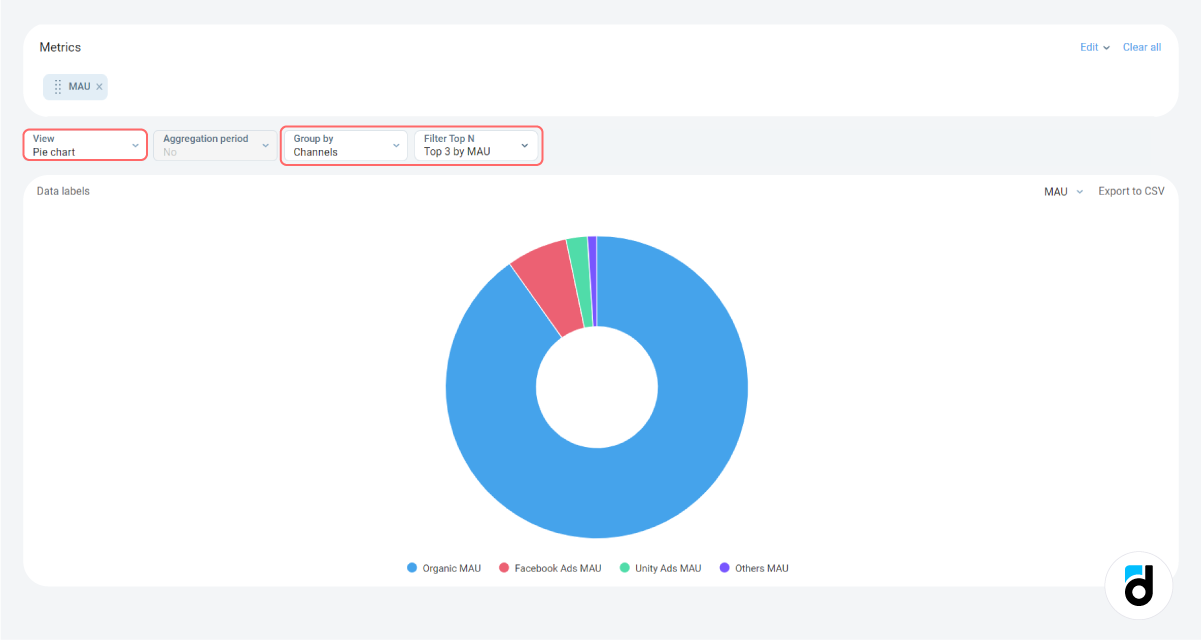
One more option of applying Devtodev analytics for analyzing MAU is to compare this metric for several projects:
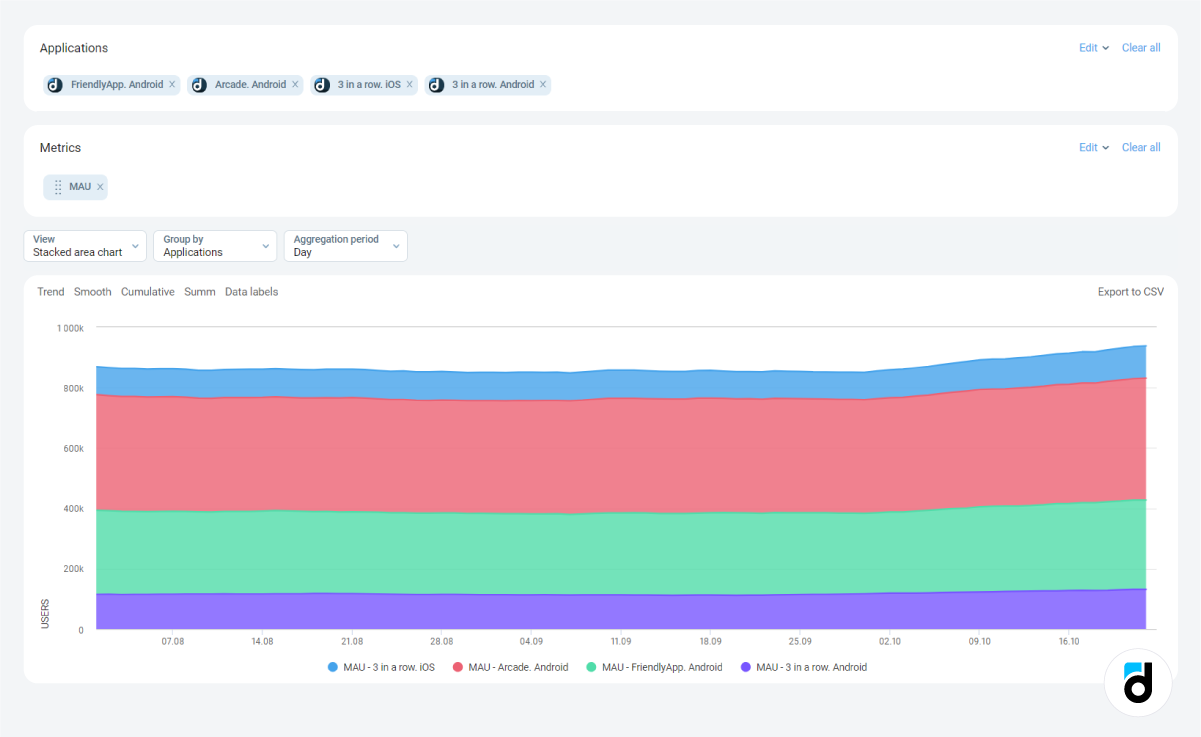
As an option, in Devtodev, you can use SQL to calculate MAU.
Factors that Influence MAU
MAU is one of the key metrics used in analytics by virtually everyone. The more active users your product has each month, the greater its potential for success.
Numerous factors influence the number of users (MAU, DAU, and WAU), ranging from on-site user experience and the quality of onboarding to virality and presence of various referral programs. These factors largely overlap with those influencing user retention. Some of the most important among them include:
-
The quality of the product and the user experience are the most important factors. A well-designed, user-friendly mobile app is more likely to attract and retain users. Ensuring that your application runs smoothly and responds to user interactions promptly is vital. Users should feel that the app is easy to navigate and visually appealing.
See our map of analytics metrics to understand their mutual influence
-
Content is king in the digital world, and mobile apps are no exception. Offering engaging content, features, and mechanics within your app is critical to boosting MAU. This means providing users with fresh challenges, updates, and activities that keep them coming back for more. Regular updates and new features can help maintain user interest.
-
First impressions matter, that's why an intuitive onboarding process and helpful in-app tutorials can significantly impact user retention. They guide new users through the initial stages of your app, making them more likely to become regular users. A seamless onboarding experience can reduce churn rates and improve MAU.
These factors are critical for attracting, retaining, and growing your user base. They lay the foundation for achieving a high MAU, as they directly impact user satisfaction, acquisition, and user retention.
For more information about user acquisition, read our free ebook
Practical Use of MAU in Analytics
MAU is a valuable metric on its own, and it also forms the foundation for various analytics processes, ranging from calculating several other essential metrics to evaluating the overall health of your app or game. Here's how you can use MAU in app and game analytics effectively:
Setting Goals and Benchmarks
This metric provides a baseline for setting goals and benchmarks for your app or game's growth. You can establish monthly targets based on historical MAU data, enabling you to track your progress and measure the success of your strategies.
Segmentation and Personalization
MAU data can be segmented to understand different user groups (see examples above). This segmentation allows for personalized approaches, targeting specific user segments with tailored content, features, and marketing campaigns to improve overall engagement.
Level of User Engagement
Analyzing MAU enables you to gauge the level of user engagement with your app. It provides a more accurate picture of your user base compared to one-time metrics like downloads or registrations.
Remember that in some cases MAU is just one piece of the analytics puzzle and it should be used in conjunction with other metrics.
Imagine you're analyzing the MAU of your project, and you notice that it remains stable month after month. Does this indicate that everything is going well? Not necessarily. It's possible that you're gaining new users at the same rate as your existing users are churning. This would keep the overall user count constant, but you'd fail to evaluate the real level of user engagement and build a stable user base, making your product's position unstable. If you were to stop acquiring new users, your app could experience a rapid decline. Therefore, it's essential to monitor not only MAU but also retention and churn metrics to ensure the health of your project.
Conclusion
In summary, MAU is a multi-functional and useful metric used in analyzing mobile apps and games. It helps you assess user engagement, evaluate marketing efforts, set benchmarks for success, and analyze user behavior,. Using MAU data effectively can lead to improved marketing efforts, user experiences, increased user retention, and sustained growth for your mobile product.











































































































































































































































































































































